Early Childhood Development: Fostering Self-Identity in Young Children
VerifiedAdded on 2022/11/14
|10
|2957
|413
Essay
AI Summary
This essay provides a comprehensive overview of early childhood development, focusing on the period from birth to five years. It examines the interconnectedness of social, emotional, and psychological growth, and how these factors contribute to the formation of a child's self-identity. The essay delves into the stages of social development, highlighting the impact of interactions with parents, educators, and peers. It also explores the progression of emotional development, from basic responses to complex feelings and the development of self-control. Furthermore, the essay discusses the psychological development of children, referencing Jean Piaget's stages and Erik Erikson's theory of psychosocial development. The role of early childhood settings and educators in promoting the psychological well-being of children is also analyzed, emphasizing the importance of interactive classes and play. Overall, the essay underscores the significance of a nurturing environment and supportive interactions in fostering a child's holistic development.
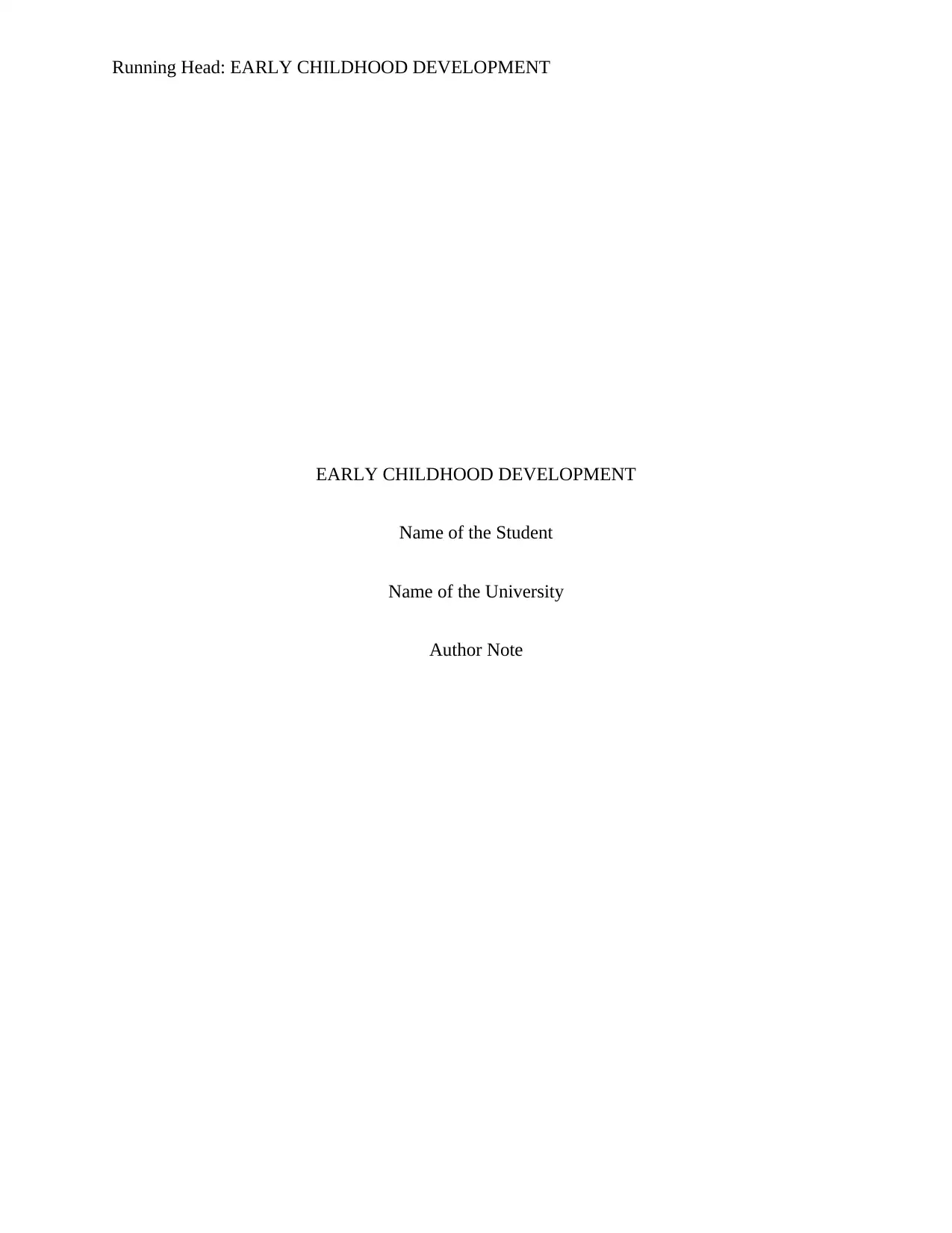
Running Head: EARLY CHILDHOOD DEVELOPMENT
EARLY CHILDHOOD DEVELOPMENT
Name of the Student
Name of the University
Author Note
EARLY CHILDHOOD DEVELOPMENT
Name of the Student
Name of the University
Author Note
Paraphrase This Document
Need a fresh take? Get an instant paraphrase of this document with our AI Paraphraser
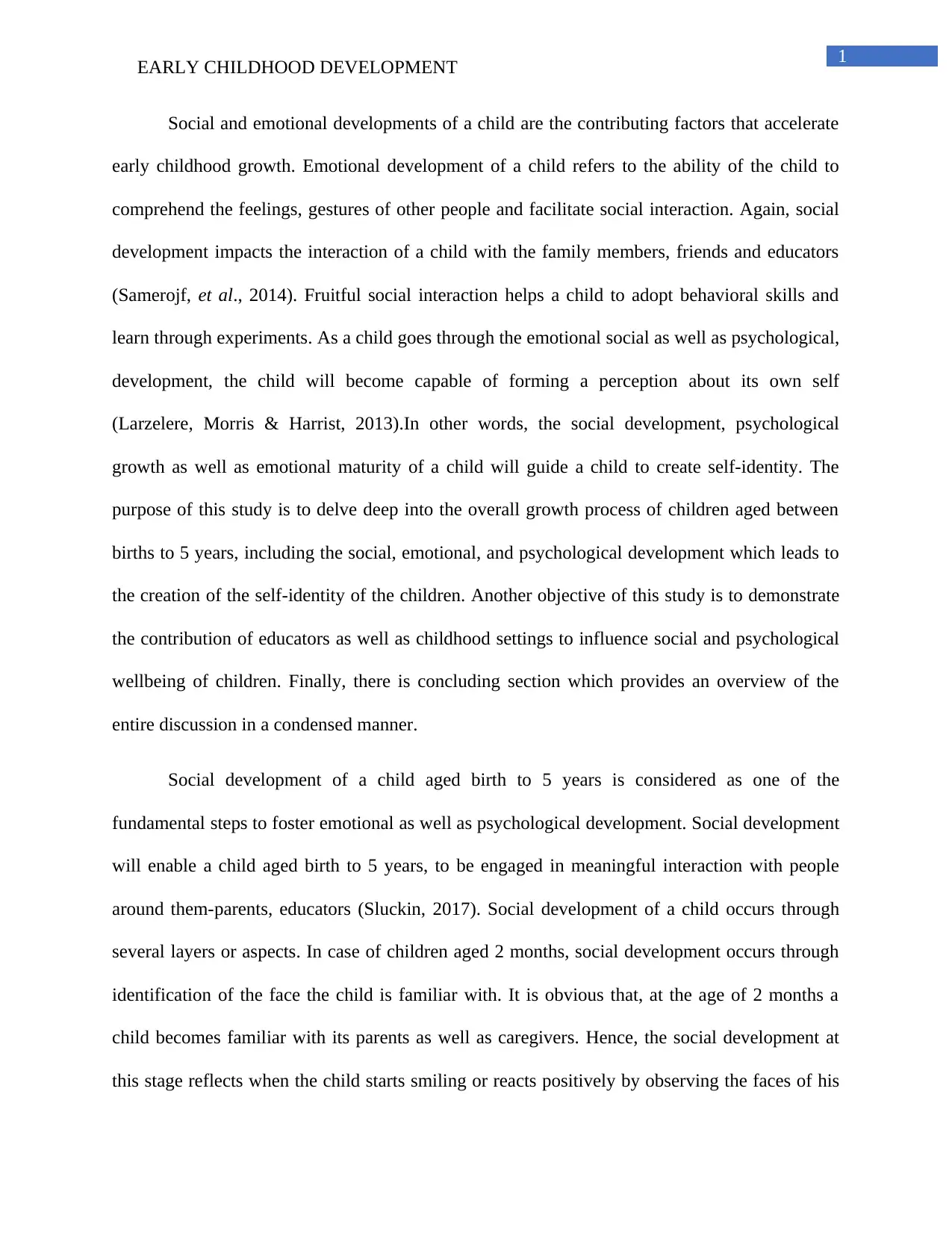
1
EARLY CHILDHOOD DEVELOPMENT
Social and emotional developments of a child are the contributing factors that accelerate
early childhood growth. Emotional development of a child refers to the ability of the child to
comprehend the feelings, gestures of other people and facilitate social interaction. Again, social
development impacts the interaction of a child with the family members, friends and educators
(Samerojf, et al., 2014). Fruitful social interaction helps a child to adopt behavioral skills and
learn through experiments. As a child goes through the emotional social as well as psychological,
development, the child will become capable of forming a perception about its own self
(Larzelere, Morris & Harrist, 2013).In other words, the social development, psychological
growth as well as emotional maturity of a child will guide a child to create self-identity. The
purpose of this study is to delve deep into the overall growth process of children aged between
births to 5 years, including the social, emotional, and psychological development which leads to
the creation of the self-identity of the children. Another objective of this study is to demonstrate
the contribution of educators as well as childhood settings to influence social and psychological
wellbeing of children. Finally, there is concluding section which provides an overview of the
entire discussion in a condensed manner.
Social development of a child aged birth to 5 years is considered as one of the
fundamental steps to foster emotional as well as psychological development. Social development
will enable a child aged birth to 5 years, to be engaged in meaningful interaction with people
around them-parents, educators (Sluckin, 2017). Social development of a child occurs through
several layers or aspects. In case of children aged 2 months, social development occurs through
identification of the face the child is familiar with. It is obvious that, at the age of 2 months a
child becomes familiar with its parents as well as caregivers. Hence, the social development at
this stage reflects when the child starts smiling or reacts positively by observing the faces of his
EARLY CHILDHOOD DEVELOPMENT
Social and emotional developments of a child are the contributing factors that accelerate
early childhood growth. Emotional development of a child refers to the ability of the child to
comprehend the feelings, gestures of other people and facilitate social interaction. Again, social
development impacts the interaction of a child with the family members, friends and educators
(Samerojf, et al., 2014). Fruitful social interaction helps a child to adopt behavioral skills and
learn through experiments. As a child goes through the emotional social as well as psychological,
development, the child will become capable of forming a perception about its own self
(Larzelere, Morris & Harrist, 2013).In other words, the social development, psychological
growth as well as emotional maturity of a child will guide a child to create self-identity. The
purpose of this study is to delve deep into the overall growth process of children aged between
births to 5 years, including the social, emotional, and psychological development which leads to
the creation of the self-identity of the children. Another objective of this study is to demonstrate
the contribution of educators as well as childhood settings to influence social and psychological
wellbeing of children. Finally, there is concluding section which provides an overview of the
entire discussion in a condensed manner.
Social development of a child aged birth to 5 years is considered as one of the
fundamental steps to foster emotional as well as psychological development. Social development
will enable a child aged birth to 5 years, to be engaged in meaningful interaction with people
around them-parents, educators (Sluckin, 2017). Social development of a child occurs through
several layers or aspects. In case of children aged 2 months, social development occurs through
identification of the face the child is familiar with. It is obvious that, at the age of 2 months a
child becomes familiar with its parents as well as caregivers. Hence, the social development at
this stage reflects when the child starts smiling or reacts positively by observing the faces of his
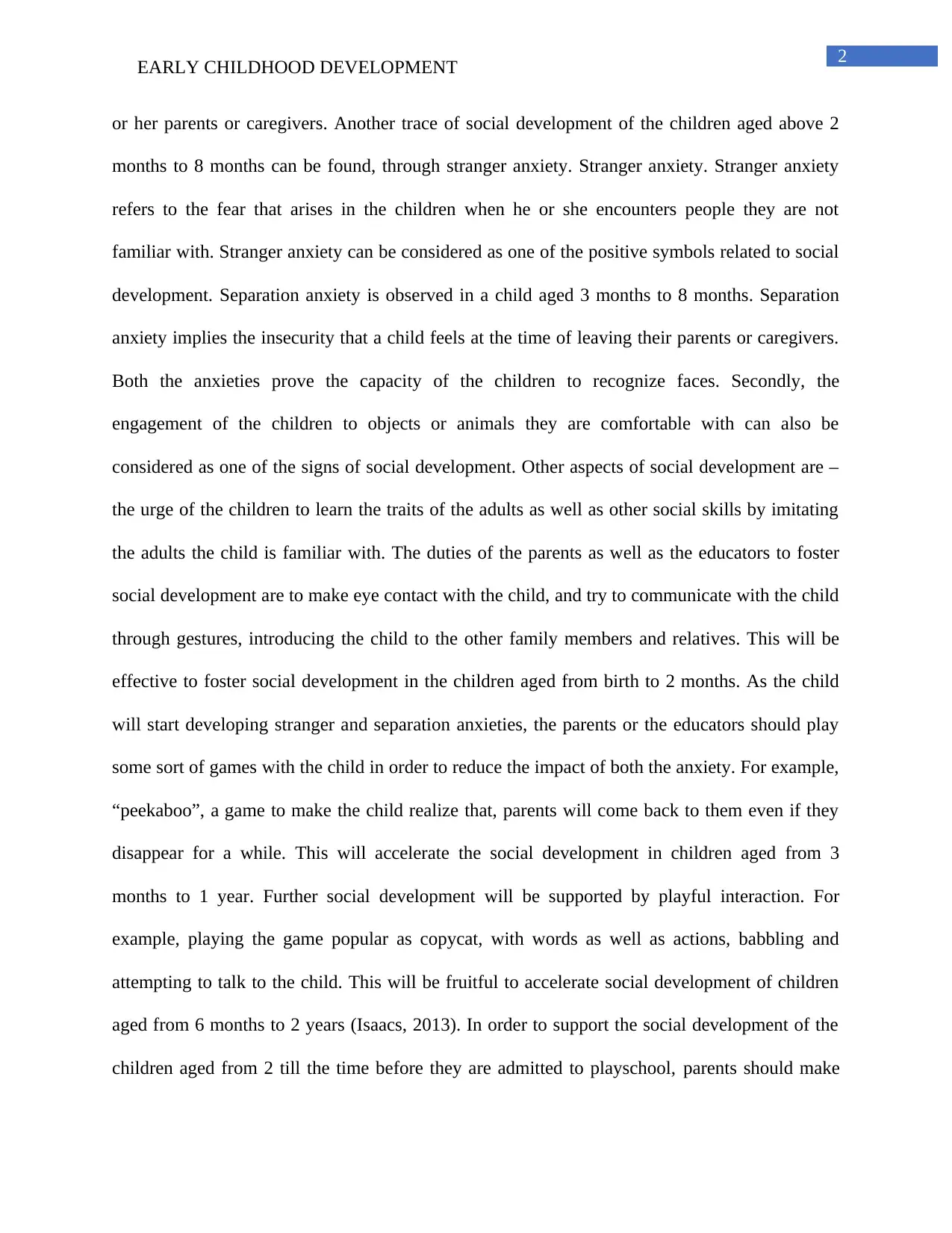
2
EARLY CHILDHOOD DEVELOPMENT
or her parents or caregivers. Another trace of social development of the children aged above 2
months to 8 months can be found, through stranger anxiety. Stranger anxiety. Stranger anxiety
refers to the fear that arises in the children when he or she encounters people they are not
familiar with. Stranger anxiety can be considered as one of the positive symbols related to social
development. Separation anxiety is observed in a child aged 3 months to 8 months. Separation
anxiety implies the insecurity that a child feels at the time of leaving their parents or caregivers.
Both the anxieties prove the capacity of the children to recognize faces. Secondly, the
engagement of the children to objects or animals they are comfortable with can also be
considered as one of the signs of social development. Other aspects of social development are –
the urge of the children to learn the traits of the adults as well as other social skills by imitating
the adults the child is familiar with. The duties of the parents as well as the educators to foster
social development are to make eye contact with the child, and try to communicate with the child
through gestures, introducing the child to the other family members and relatives. This will be
effective to foster social development in the children aged from birth to 2 months. As the child
will start developing stranger and separation anxieties, the parents or the educators should play
some sort of games with the child in order to reduce the impact of both the anxiety. For example,
“peekaboo”, a game to make the child realize that, parents will come back to them even if they
disappear for a while. This will accelerate the social development in children aged from 3
months to 1 year. Further social development will be supported by playful interaction. For
example, playing the game popular as copycat, with words as well as actions, babbling and
attempting to talk to the child. This will be fruitful to accelerate social development of children
aged from 6 months to 2 years (Isaacs, 2013). In order to support the social development of the
children aged from 2 till the time before they are admitted to playschool, parents should make
EARLY CHILDHOOD DEVELOPMENT
or her parents or caregivers. Another trace of social development of the children aged above 2
months to 8 months can be found, through stranger anxiety. Stranger anxiety. Stranger anxiety
refers to the fear that arises in the children when he or she encounters people they are not
familiar with. Stranger anxiety can be considered as one of the positive symbols related to social
development. Separation anxiety is observed in a child aged 3 months to 8 months. Separation
anxiety implies the insecurity that a child feels at the time of leaving their parents or caregivers.
Both the anxieties prove the capacity of the children to recognize faces. Secondly, the
engagement of the children to objects or animals they are comfortable with can also be
considered as one of the signs of social development. Other aspects of social development are –
the urge of the children to learn the traits of the adults as well as other social skills by imitating
the adults the child is familiar with. The duties of the parents as well as the educators to foster
social development are to make eye contact with the child, and try to communicate with the child
through gestures, introducing the child to the other family members and relatives. This will be
effective to foster social development in the children aged from birth to 2 months. As the child
will start developing stranger and separation anxieties, the parents or the educators should play
some sort of games with the child in order to reduce the impact of both the anxiety. For example,
“peekaboo”, a game to make the child realize that, parents will come back to them even if they
disappear for a while. This will accelerate the social development in children aged from 3
months to 1 year. Further social development will be supported by playful interaction. For
example, playing the game popular as copycat, with words as well as actions, babbling and
attempting to talk to the child. This will be fruitful to accelerate social development of children
aged from 6 months to 2 years (Isaacs, 2013). In order to support the social development of the
children aged from 2 till the time before they are admitted to playschool, parents should make
⊘ This is a preview!⊘
Do you want full access?
Subscribe today to unlock all pages.

Trusted by 1+ million students worldwide
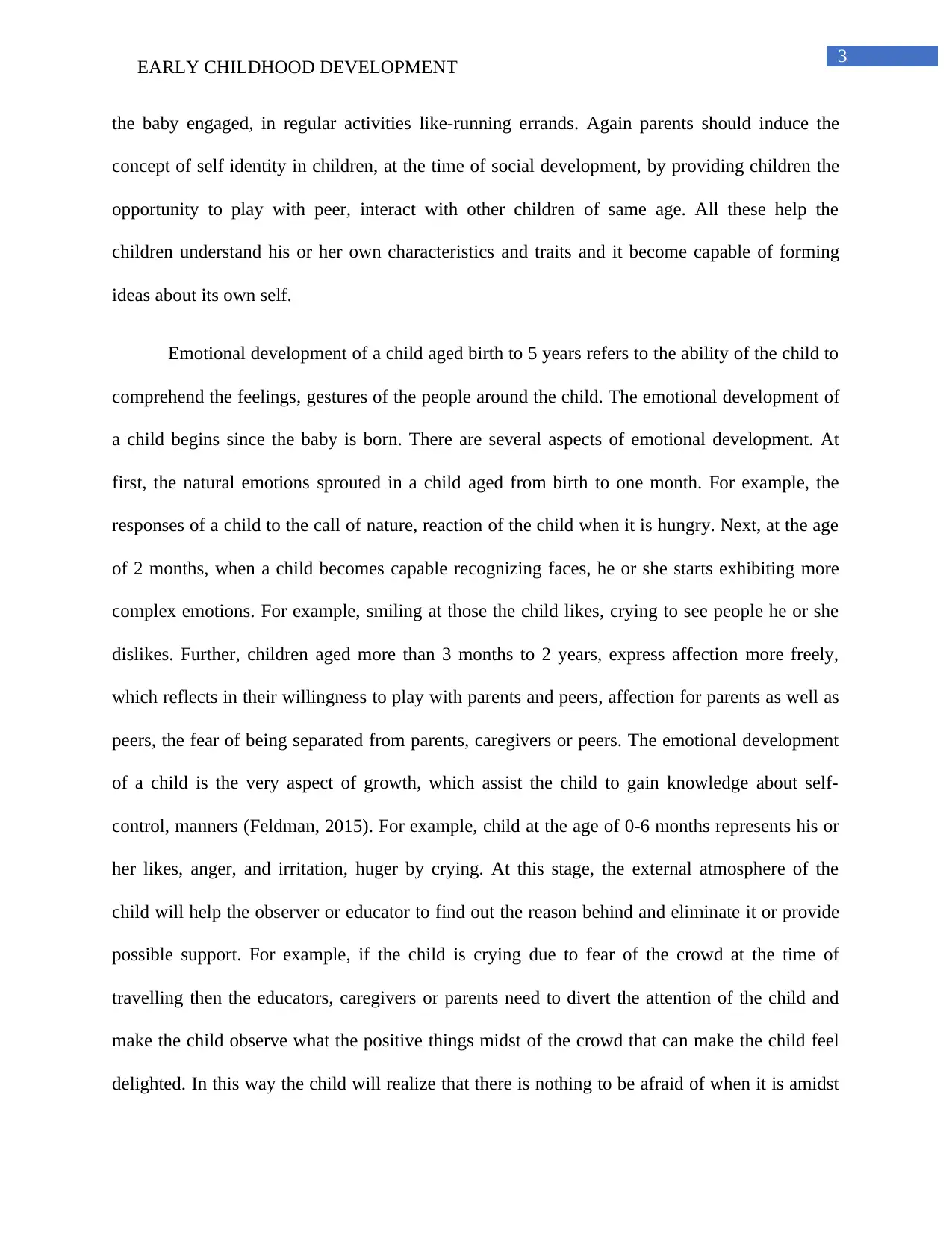
3
EARLY CHILDHOOD DEVELOPMENT
the baby engaged, in regular activities like-running errands. Again parents should induce the
concept of self identity in children, at the time of social development, by providing children the
opportunity to play with peer, interact with other children of same age. All these help the
children understand his or her own characteristics and traits and it become capable of forming
ideas about its own self.
Emotional development of a child aged birth to 5 years refers to the ability of the child to
comprehend the feelings, gestures of the people around the child. The emotional development of
a child begins since the baby is born. There are several aspects of emotional development. At
first, the natural emotions sprouted in a child aged from birth to one month. For example, the
responses of a child to the call of nature, reaction of the child when it is hungry. Next, at the age
of 2 months, when a child becomes capable recognizing faces, he or she starts exhibiting more
complex emotions. For example, smiling at those the child likes, crying to see people he or she
dislikes. Further, children aged more than 3 months to 2 years, express affection more freely,
which reflects in their willingness to play with parents and peers, affection for parents as well as
peers, the fear of being separated from parents, caregivers or peers. The emotional development
of a child is the very aspect of growth, which assist the child to gain knowledge about self-
control, manners (Feldman, 2015). For example, child at the age of 0-6 months represents his or
her likes, anger, and irritation, huger by crying. At this stage, the external atmosphere of the
child will help the observer or educator to find out the reason behind and eliminate it or provide
possible support. For example, if the child is crying due to fear of the crowd at the time of
travelling then the educators, caregivers or parents need to divert the attention of the child and
make the child observe what the positive things midst of the crowd that can make the child feel
delighted. In this way the child will realize that there is nothing to be afraid of when it is amidst
EARLY CHILDHOOD DEVELOPMENT
the baby engaged, in regular activities like-running errands. Again parents should induce the
concept of self identity in children, at the time of social development, by providing children the
opportunity to play with peer, interact with other children of same age. All these help the
children understand his or her own characteristics and traits and it become capable of forming
ideas about its own self.
Emotional development of a child aged birth to 5 years refers to the ability of the child to
comprehend the feelings, gestures of the people around the child. The emotional development of
a child begins since the baby is born. There are several aspects of emotional development. At
first, the natural emotions sprouted in a child aged from birth to one month. For example, the
responses of a child to the call of nature, reaction of the child when it is hungry. Next, at the age
of 2 months, when a child becomes capable recognizing faces, he or she starts exhibiting more
complex emotions. For example, smiling at those the child likes, crying to see people he or she
dislikes. Further, children aged more than 3 months to 2 years, express affection more freely,
which reflects in their willingness to play with parents and peers, affection for parents as well as
peers, the fear of being separated from parents, caregivers or peers. The emotional development
of a child is the very aspect of growth, which assist the child to gain knowledge about self-
control, manners (Feldman, 2015). For example, child at the age of 0-6 months represents his or
her likes, anger, and irritation, huger by crying. At this stage, the external atmosphere of the
child will help the observer or educator to find out the reason behind and eliminate it or provide
possible support. For example, if the child is crying due to fear of the crowd at the time of
travelling then the educators, caregivers or parents need to divert the attention of the child and
make the child observe what the positive things midst of the crowd that can make the child feel
delighted. In this way the child will realize that there is nothing to be afraid of when it is amidst
Paraphrase This Document
Need a fresh take? Get an instant paraphrase of this document with our AI Paraphraser
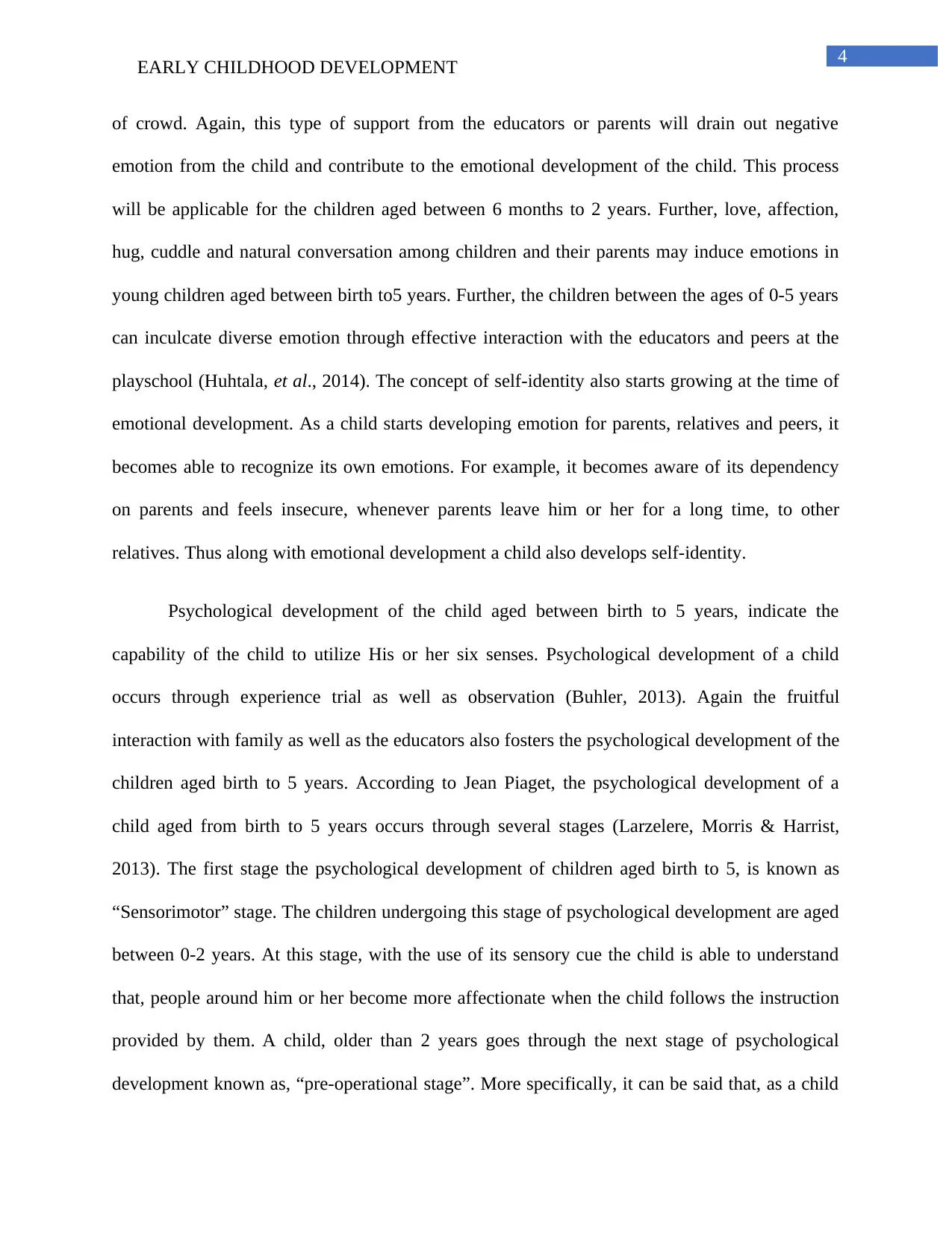
4
EARLY CHILDHOOD DEVELOPMENT
of crowd. Again, this type of support from the educators or parents will drain out negative
emotion from the child and contribute to the emotional development of the child. This process
will be applicable for the children aged between 6 months to 2 years. Further, love, affection,
hug, cuddle and natural conversation among children and their parents may induce emotions in
young children aged between birth to5 years. Further, the children between the ages of 0-5 years
can inculcate diverse emotion through effective interaction with the educators and peers at the
playschool (Huhtala, et al., 2014). The concept of self-identity also starts growing at the time of
emotional development. As a child starts developing emotion for parents, relatives and peers, it
becomes able to recognize its own emotions. For example, it becomes aware of its dependency
on parents and feels insecure, whenever parents leave him or her for a long time, to other
relatives. Thus along with emotional development a child also develops self-identity.
Psychological development of the child aged between birth to 5 years, indicate the
capability of the child to utilize His or her six senses. Psychological development of a child
occurs through experience trial as well as observation (Buhler, 2013). Again the fruitful
interaction with family as well as the educators also fosters the psychological development of the
children aged birth to 5 years. According to Jean Piaget, the psychological development of a
child aged from birth to 5 years occurs through several stages (Larzelere, Morris & Harrist,
2013). The first stage the psychological development of children aged birth to 5, is known as
“Sensorimotor” stage. The children undergoing this stage of psychological development are aged
between 0-2 years. At this stage, with the use of its sensory cue the child is able to understand
that, people around him or her become more affectionate when the child follows the instruction
provided by them. A child, older than 2 years goes through the next stage of psychological
development known as, “pre-operational stage”. More specifically, it can be said that, as a child
EARLY CHILDHOOD DEVELOPMENT
of crowd. Again, this type of support from the educators or parents will drain out negative
emotion from the child and contribute to the emotional development of the child. This process
will be applicable for the children aged between 6 months to 2 years. Further, love, affection,
hug, cuddle and natural conversation among children and their parents may induce emotions in
young children aged between birth to5 years. Further, the children between the ages of 0-5 years
can inculcate diverse emotion through effective interaction with the educators and peers at the
playschool (Huhtala, et al., 2014). The concept of self-identity also starts growing at the time of
emotional development. As a child starts developing emotion for parents, relatives and peers, it
becomes able to recognize its own emotions. For example, it becomes aware of its dependency
on parents and feels insecure, whenever parents leave him or her for a long time, to other
relatives. Thus along with emotional development a child also develops self-identity.
Psychological development of the child aged between birth to 5 years, indicate the
capability of the child to utilize His or her six senses. Psychological development of a child
occurs through experience trial as well as observation (Buhler, 2013). Again the fruitful
interaction with family as well as the educators also fosters the psychological development of the
children aged birth to 5 years. According to Jean Piaget, the psychological development of a
child aged from birth to 5 years occurs through several stages (Larzelere, Morris & Harrist,
2013). The first stage the psychological development of children aged birth to 5, is known as
“Sensorimotor” stage. The children undergoing this stage of psychological development are aged
between 0-2 years. At this stage, with the use of its sensory cue the child is able to understand
that, people around him or her become more affectionate when the child follows the instruction
provided by them. A child, older than 2 years goes through the next stage of psychological
development known as, “pre-operational stage”. More specifically, it can be said that, as a child
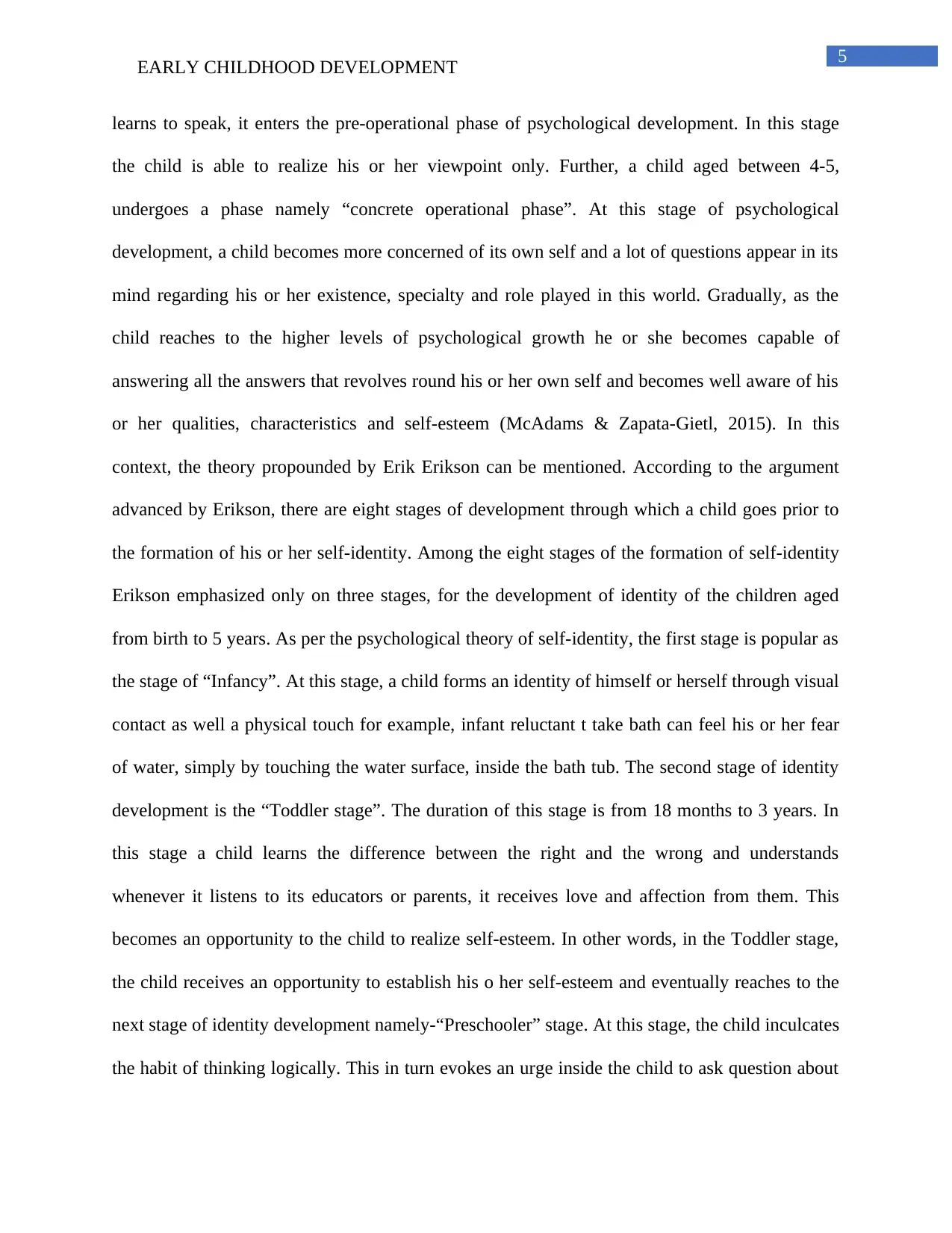
5
EARLY CHILDHOOD DEVELOPMENT
learns to speak, it enters the pre-operational phase of psychological development. In this stage
the child is able to realize his or her viewpoint only. Further, a child aged between 4-5,
undergoes a phase namely “concrete operational phase”. At this stage of psychological
development, a child becomes more concerned of its own self and a lot of questions appear in its
mind regarding his or her existence, specialty and role played in this world. Gradually, as the
child reaches to the higher levels of psychological growth he or she becomes capable of
answering all the answers that revolves round his or her own self and becomes well aware of his
or her qualities, characteristics and self-esteem (McAdams & Zapata-Gietl, 2015). In this
context, the theory propounded by Erik Erikson can be mentioned. According to the argument
advanced by Erikson, there are eight stages of development through which a child goes prior to
the formation of his or her self-identity. Among the eight stages of the formation of self-identity
Erikson emphasized only on three stages, for the development of identity of the children aged
from birth to 5 years. As per the psychological theory of self-identity, the first stage is popular as
the stage of “Infancy”. At this stage, a child forms an identity of himself or herself through visual
contact as well a physical touch for example, infant reluctant t take bath can feel his or her fear
of water, simply by touching the water surface, inside the bath tub. The second stage of identity
development is the “Toddler stage”. The duration of this stage is from 18 months to 3 years. In
this stage a child learns the difference between the right and the wrong and understands
whenever it listens to its educators or parents, it receives love and affection from them. This
becomes an opportunity to the child to realize self-esteem. In other words, in the Toddler stage,
the child receives an opportunity to establish his o her self-esteem and eventually reaches to the
next stage of identity development namely-“Preschooler” stage. At this stage, the child inculcates
the habit of thinking logically. This in turn evokes an urge inside the child to ask question about
EARLY CHILDHOOD DEVELOPMENT
learns to speak, it enters the pre-operational phase of psychological development. In this stage
the child is able to realize his or her viewpoint only. Further, a child aged between 4-5,
undergoes a phase namely “concrete operational phase”. At this stage of psychological
development, a child becomes more concerned of its own self and a lot of questions appear in its
mind regarding his or her existence, specialty and role played in this world. Gradually, as the
child reaches to the higher levels of psychological growth he or she becomes capable of
answering all the answers that revolves round his or her own self and becomes well aware of his
or her qualities, characteristics and self-esteem (McAdams & Zapata-Gietl, 2015). In this
context, the theory propounded by Erik Erikson can be mentioned. According to the argument
advanced by Erikson, there are eight stages of development through which a child goes prior to
the formation of his or her self-identity. Among the eight stages of the formation of self-identity
Erikson emphasized only on three stages, for the development of identity of the children aged
from birth to 5 years. As per the psychological theory of self-identity, the first stage is popular as
the stage of “Infancy”. At this stage, a child forms an identity of himself or herself through visual
contact as well a physical touch for example, infant reluctant t take bath can feel his or her fear
of water, simply by touching the water surface, inside the bath tub. The second stage of identity
development is the “Toddler stage”. The duration of this stage is from 18 months to 3 years. In
this stage a child learns the difference between the right and the wrong and understands
whenever it listens to its educators or parents, it receives love and affection from them. This
becomes an opportunity to the child to realize self-esteem. In other words, in the Toddler stage,
the child receives an opportunity to establish his o her self-esteem and eventually reaches to the
next stage of identity development namely-“Preschooler” stage. At this stage, the child inculcates
the habit of thinking logically. This in turn evokes an urge inside the child to ask question about
⊘ This is a preview!⊘
Do you want full access?
Subscribe today to unlock all pages.

Trusted by 1+ million students worldwide
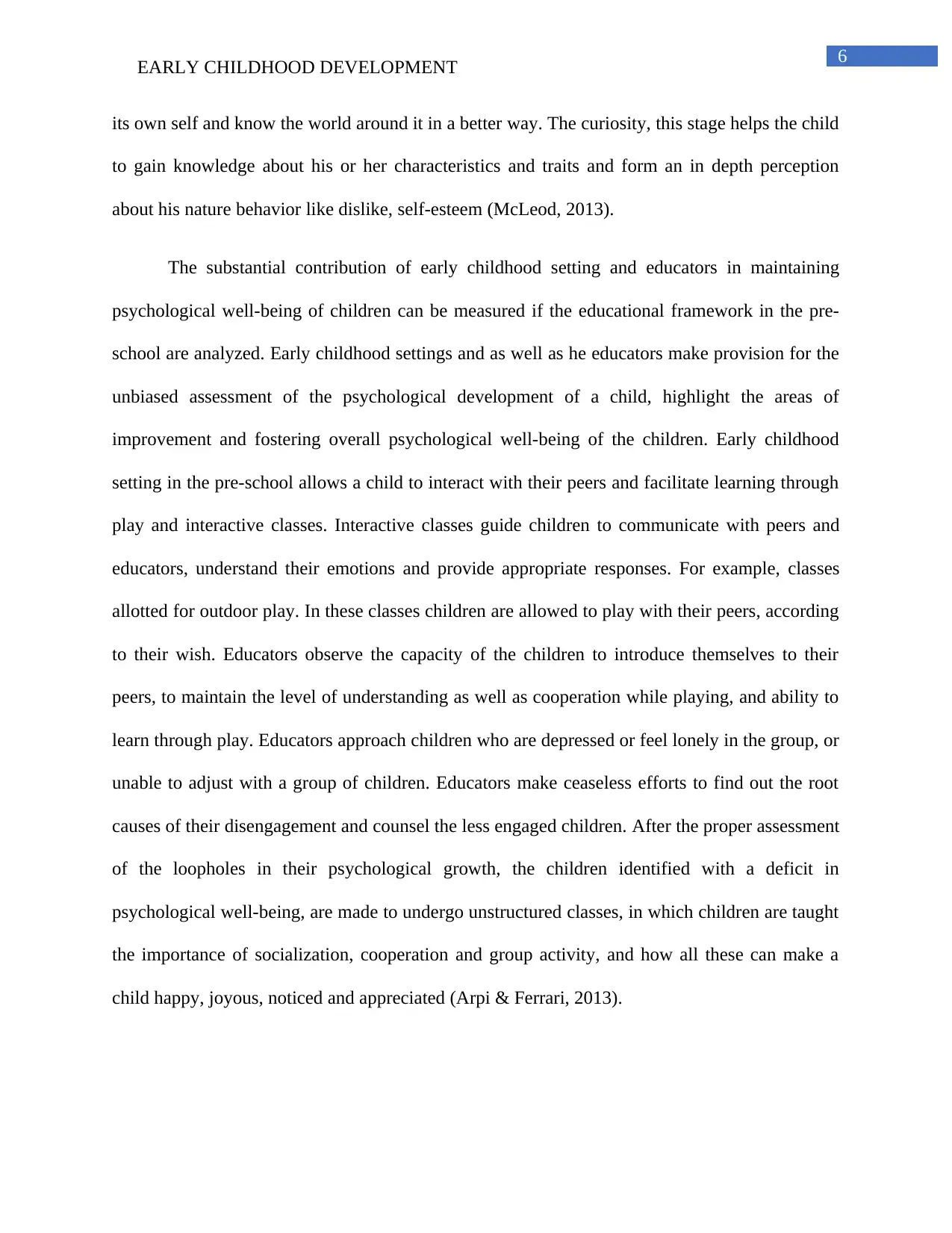
6
EARLY CHILDHOOD DEVELOPMENT
its own self and know the world around it in a better way. The curiosity, this stage helps the child
to gain knowledge about his or her characteristics and traits and form an in depth perception
about his nature behavior like dislike, self-esteem (McLeod, 2013).
The substantial contribution of early childhood setting and educators in maintaining
psychological well-being of children can be measured if the educational framework in the pre-
school are analyzed. Early childhood settings and as well as he educators make provision for the
unbiased assessment of the psychological development of a child, highlight the areas of
improvement and fostering overall psychological well-being of the children. Early childhood
setting in the pre-school allows a child to interact with their peers and facilitate learning through
play and interactive classes. Interactive classes guide children to communicate with peers and
educators, understand their emotions and provide appropriate responses. For example, classes
allotted for outdoor play. In these classes children are allowed to play with their peers, according
to their wish. Educators observe the capacity of the children to introduce themselves to their
peers, to maintain the level of understanding as well as cooperation while playing, and ability to
learn through play. Educators approach children who are depressed or feel lonely in the group, or
unable to adjust with a group of children. Educators make ceaseless efforts to find out the root
causes of their disengagement and counsel the less engaged children. After the proper assessment
of the loopholes in their psychological growth, the children identified with a deficit in
psychological well-being, are made to undergo unstructured classes, in which children are taught
the importance of socialization, cooperation and group activity, and how all these can make a
child happy, joyous, noticed and appreciated (Arpi & Ferrari, 2013).
EARLY CHILDHOOD DEVELOPMENT
its own self and know the world around it in a better way. The curiosity, this stage helps the child
to gain knowledge about his or her characteristics and traits and form an in depth perception
about his nature behavior like dislike, self-esteem (McLeod, 2013).
The substantial contribution of early childhood setting and educators in maintaining
psychological well-being of children can be measured if the educational framework in the pre-
school are analyzed. Early childhood settings and as well as he educators make provision for the
unbiased assessment of the psychological development of a child, highlight the areas of
improvement and fostering overall psychological well-being of the children. Early childhood
setting in the pre-school allows a child to interact with their peers and facilitate learning through
play and interactive classes. Interactive classes guide children to communicate with peers and
educators, understand their emotions and provide appropriate responses. For example, classes
allotted for outdoor play. In these classes children are allowed to play with their peers, according
to their wish. Educators observe the capacity of the children to introduce themselves to their
peers, to maintain the level of understanding as well as cooperation while playing, and ability to
learn through play. Educators approach children who are depressed or feel lonely in the group, or
unable to adjust with a group of children. Educators make ceaseless efforts to find out the root
causes of their disengagement and counsel the less engaged children. After the proper assessment
of the loopholes in their psychological growth, the children identified with a deficit in
psychological well-being, are made to undergo unstructured classes, in which children are taught
the importance of socialization, cooperation and group activity, and how all these can make a
child happy, joyous, noticed and appreciated (Arpi & Ferrari, 2013).
Paraphrase This Document
Need a fresh take? Get an instant paraphrase of this document with our AI Paraphraser
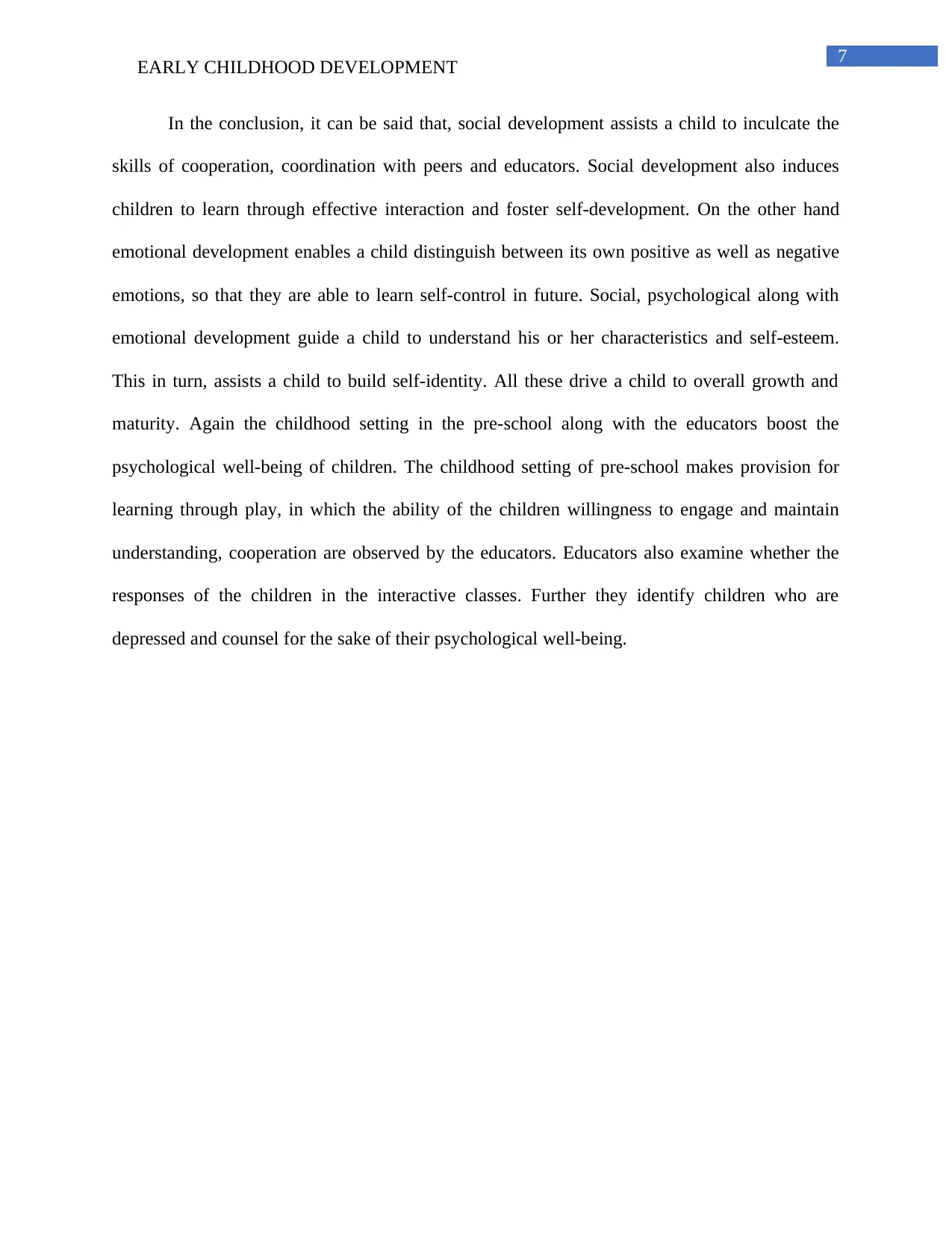
7
EARLY CHILDHOOD DEVELOPMENT
In the conclusion, it can be said that, social development assists a child to inculcate the
skills of cooperation, coordination with peers and educators. Social development also induces
children to learn through effective interaction and foster self-development. On the other hand
emotional development enables a child distinguish between its own positive as well as negative
emotions, so that they are able to learn self-control in future. Social, psychological along with
emotional development guide a child to understand his or her characteristics and self-esteem.
This in turn, assists a child to build self-identity. All these drive a child to overall growth and
maturity. Again the childhood setting in the pre-school along with the educators boost the
psychological well-being of children. The childhood setting of pre-school makes provision for
learning through play, in which the ability of the children willingness to engage and maintain
understanding, cooperation are observed by the educators. Educators also examine whether the
responses of the children in the interactive classes. Further they identify children who are
depressed and counsel for the sake of their psychological well-being.
EARLY CHILDHOOD DEVELOPMENT
In the conclusion, it can be said that, social development assists a child to inculcate the
skills of cooperation, coordination with peers and educators. Social development also induces
children to learn through effective interaction and foster self-development. On the other hand
emotional development enables a child distinguish between its own positive as well as negative
emotions, so that they are able to learn self-control in future. Social, psychological along with
emotional development guide a child to understand his or her characteristics and self-esteem.
This in turn, assists a child to build self-identity. All these drive a child to overall growth and
maturity. Again the childhood setting in the pre-school along with the educators boost the
psychological well-being of children. The childhood setting of pre-school makes provision for
learning through play, in which the ability of the children willingness to engage and maintain
understanding, cooperation are observed by the educators. Educators also examine whether the
responses of the children in the interactive classes. Further they identify children who are
depressed and counsel for the sake of their psychological well-being.
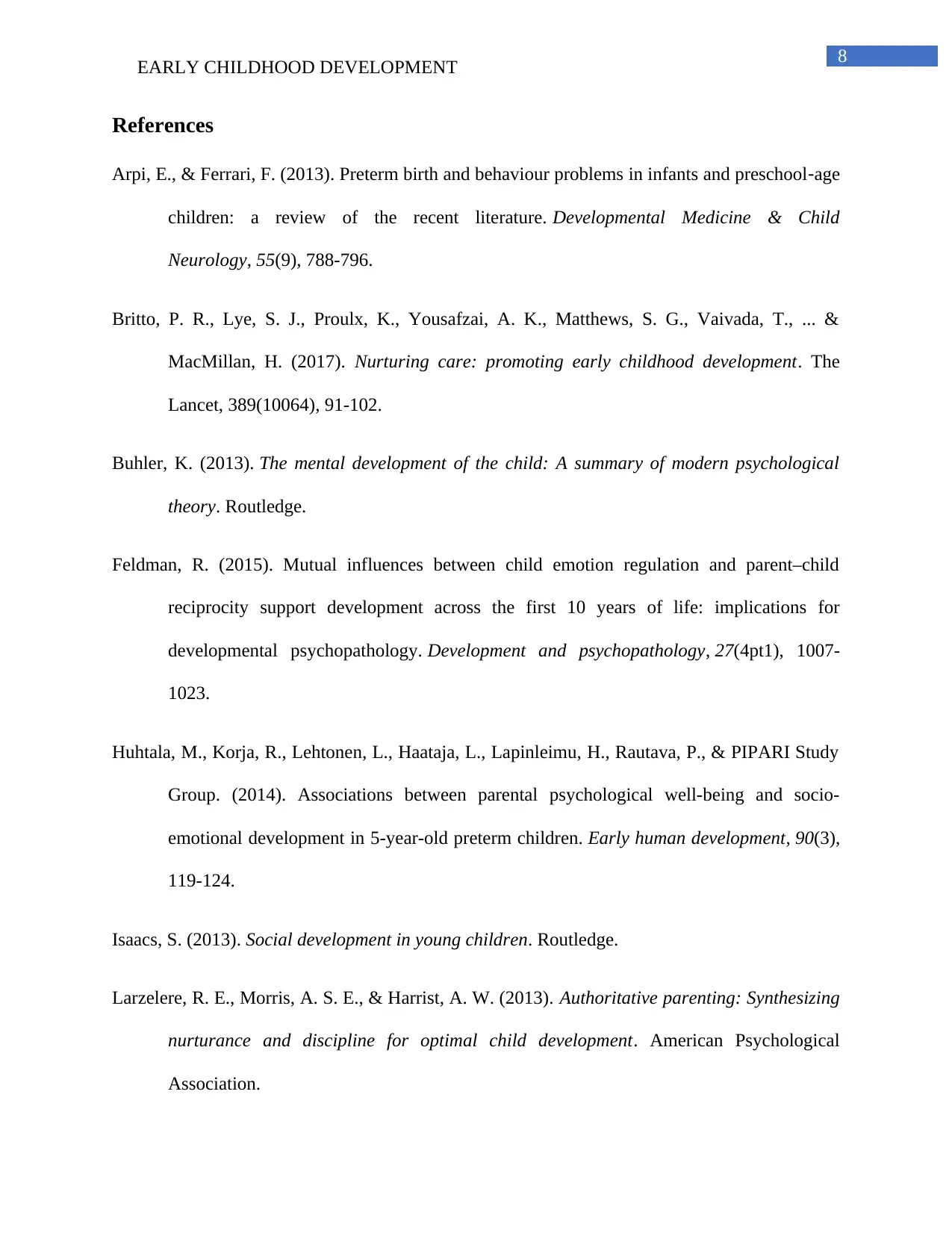
8
EARLY CHILDHOOD DEVELOPMENT
References
Arpi, E., & Ferrari, F. (2013). Preterm birth and behaviour problems in infants and preschool‐age
children: a review of the recent literature. Developmental Medicine & Child
Neurology, 55(9), 788-796.
Britto, P. R., Lye, S. J., Proulx, K., Yousafzai, A. K., Matthews, S. G., Vaivada, T., ... &
MacMillan, H. (2017). Nurturing care: promoting early childhood development. The
Lancet, 389(10064), 91-102.
Buhler, K. (2013). The mental development of the child: A summary of modern psychological
theory. Routledge.
Feldman, R. (2015). Mutual influences between child emotion regulation and parent–child
reciprocity support development across the first 10 years of life: implications for
developmental psychopathology. Development and psychopathology, 27(4pt1), 1007-
1023.
Huhtala, M., Korja, R., Lehtonen, L., Haataja, L., Lapinleimu, H., Rautava, P., & PIPARI Study
Group. (2014). Associations between parental psychological well-being and socio-
emotional development in 5-year-old preterm children. Early human development, 90(3),
119-124.
Isaacs, S. (2013). Social development in young children. Routledge.
Larzelere, R. E., Morris, A. S. E., & Harrist, A. W. (2013). Authoritative parenting: Synthesizing
nurturance and discipline for optimal child development. American Psychological
Association.
EARLY CHILDHOOD DEVELOPMENT
References
Arpi, E., & Ferrari, F. (2013). Preterm birth and behaviour problems in infants and preschool‐age
children: a review of the recent literature. Developmental Medicine & Child
Neurology, 55(9), 788-796.
Britto, P. R., Lye, S. J., Proulx, K., Yousafzai, A. K., Matthews, S. G., Vaivada, T., ... &
MacMillan, H. (2017). Nurturing care: promoting early childhood development. The
Lancet, 389(10064), 91-102.
Buhler, K. (2013). The mental development of the child: A summary of modern psychological
theory. Routledge.
Feldman, R. (2015). Mutual influences between child emotion regulation and parent–child
reciprocity support development across the first 10 years of life: implications for
developmental psychopathology. Development and psychopathology, 27(4pt1), 1007-
1023.
Huhtala, M., Korja, R., Lehtonen, L., Haataja, L., Lapinleimu, H., Rautava, P., & PIPARI Study
Group. (2014). Associations between parental psychological well-being and socio-
emotional development in 5-year-old preterm children. Early human development, 90(3),
119-124.
Isaacs, S. (2013). Social development in young children. Routledge.
Larzelere, R. E., Morris, A. S. E., & Harrist, A. W. (2013). Authoritative parenting: Synthesizing
nurturance and discipline for optimal child development. American Psychological
Association.
⊘ This is a preview!⊘
Do you want full access?
Subscribe today to unlock all pages.

Trusted by 1+ million students worldwide
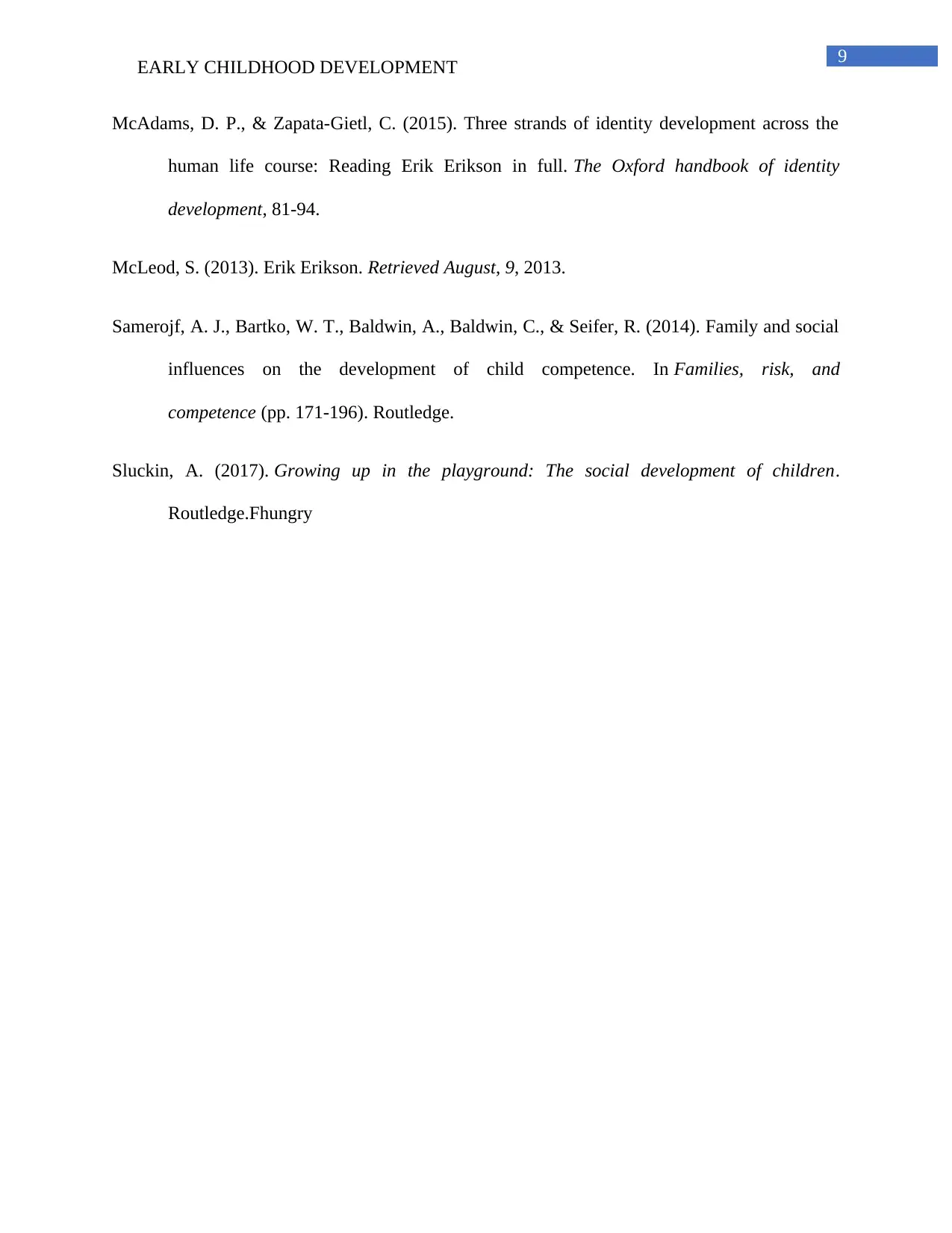
9
EARLY CHILDHOOD DEVELOPMENT
McAdams, D. P., & Zapata-Gietl, C. (2015). Three strands of identity development across the
human life course: Reading Erik Erikson in full. The Oxford handbook of identity
development, 81-94.
McLeod, S. (2013). Erik Erikson. Retrieved August, 9, 2013.
Samerojf, A. J., Bartko, W. T., Baldwin, A., Baldwin, C., & Seifer, R. (2014). Family and social
influences on the development of child competence. In Families, risk, and
competence (pp. 171-196). Routledge.
Sluckin, A. (2017). Growing up in the playground: The social development of children.
Routledge.Fhungry
EARLY CHILDHOOD DEVELOPMENT
McAdams, D. P., & Zapata-Gietl, C. (2015). Three strands of identity development across the
human life course: Reading Erik Erikson in full. The Oxford handbook of identity
development, 81-94.
McLeod, S. (2013). Erik Erikson. Retrieved August, 9, 2013.
Samerojf, A. J., Bartko, W. T., Baldwin, A., Baldwin, C., & Seifer, R. (2014). Family and social
influences on the development of child competence. In Families, risk, and
competence (pp. 171-196). Routledge.
Sluckin, A. (2017). Growing up in the playground: The social development of children.
Routledge.Fhungry
1 out of 10
Related Documents
Your All-in-One AI-Powered Toolkit for Academic Success.
+13062052269
info@desklib.com
Available 24*7 on WhatsApp / Email
![[object Object]](/_next/static/media/star-bottom.7253800d.svg)
Unlock your academic potential
Copyright © 2020–2025 A2Z Services. All Rights Reserved. Developed and managed by ZUCOL.





